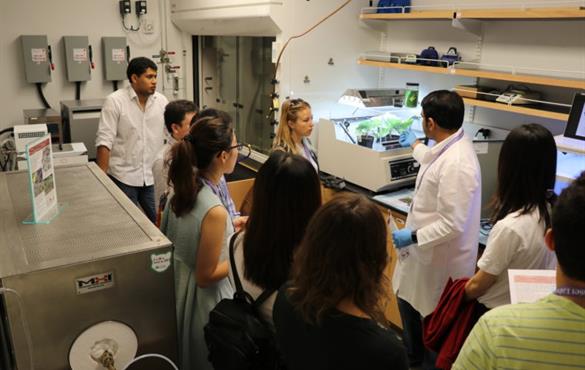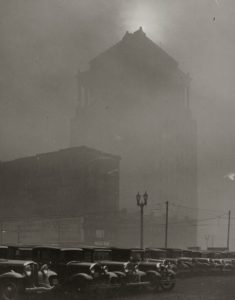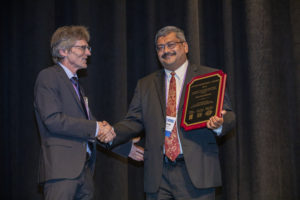Research comes full circle at International Aerosol Conference
Recently, more than 1,500 of the world’s preeminent aerosol scientists gathered in St. Louis for the 10th International Aerosol Conference (IAC). The event is held every four years, and only every 12 years in the United States

The School of Engineering & Applied Science hosts some of the world’s best aerosol experts from 48 different countries here in St. Louis.
Recently, more than 1,500 of the world’s preeminent aerosol scientists gathered in St. Louis for the 10th International Aerosol Conference (IAC). Held every four years — and only every 12 years in the United States — the event took place Sept. 2-7 at the Americas Center. The conference was opened by Chancellor Mark S. Wrighton, who welcomed the attendees from 48 different countries to St. Louis.
Washington University in St. Louis has one of the country’s leading aerosol centers (Center for Aerosol Science and Engineering, or CASE), and its faculty in the School of Engineering & Applied Science helped organize the program by presenting research and talks centered aerosol science and engineering. Eight faculty members and their students had more than 65 presentations at the conference.
“This is a wide-ranging and fascinating field,” said Pratim Biswas, assistant vice chancellor, chair of the Department of Energy, Environmental & Chemical Engineering and the Lucy & Stanley Lopata Professor at the School of Engineering & Applied Science, who chaired the conference. “Washington University is leading the way when it comes to this important focus of study, and we were so pleased to host some of the world’s best aerosol experts here in St. Louis for IAC 2018.”
While the word aerosol may immediately bring to mind a can of hairspray or paint, this scientific research focuses on so much more than an application system. Aerosol science and engineering deals with the formation, growth, transport and deposition of small particles. It is considered an “enabling discipline,” encompassing everything from fighting smog and understanding impacts on climate and mitigation impacts, to designing better drug delivery for cancer patients, better design of solar cells, and even more efficient crop fertilization techniques falls under the field.
And it’s a field in which Washington University engineers have been at the forefront for more than eight decades.
Headlights at high noon

Nearly 80 years ago, St. Louis faced an environmental crisis unlike any the city had ever weathered: Thick, choking smoke had long been a problem for the city due to generations of St. Louisans routinely burning coal to keep their homes warm. By the 1930s, the problem had grown to epidemic proportions. Thick smoke routinely blanketed the city, making it necessary at time to turn on headlights and streetlights in the middle of the day.
As the smog worsened, Washington University engineers of the day studied St. Louis’ dirty air, its effects and possible mitigation techniques. Raymond Tucker, then-chair of the mechanical engineering department, eventually became the city smoke commissioner, putting policies into place to cut the smog, including forcing business to burn cleaner coal and creating emissions standards. These measures resulted in much cleaner, safer air for the city. Tucker eventually became mayor, serving the city from 1953-1965..
Biswas said Washington University’s role now—as it was then—is equally important.
“Around the globe, there are still air pollution issues,” he said. “In the 1930s, our university helped pioneer solutions for cleaner air. That is what we hope will happen around the world, and it is still our goal some 80 years later. People are very concerned and want solutions. There are rather innovative approaches being developed by aerosol scientists, and we saw examples presented at the IAC.”

Recognition for research
The conference also drew special recognition for Washington University. Biswas received the highest honor given to aerosol scientists, the Fuchs Award. The award is given out once in four years to a researcher who has made exemplary contributions in aerosol science and technology.
Two CASE alumni also received special honors: the American Association for Aerosol Research honored Chris Hogan with the Whitby Award; the German Aerosol Association presented Jingkun Jiang its Smoluchowski Award. Several Washington University students also won best poster awards.
Outside of research talks and presentations at the conference, Biswas and his School of Engineering & Applied Science colleagues also served as St. Louis and Washington University ambassadors. More than 300 attendees took tours of the school’s engineering labs, and enjoyed a reception hosted by Dean Aaron Bobick. Tours of Cortex and other places of interest also were arranged, and St. Louis Mayor Lyda Krewson proclaimed it “Aerosol Science and Engineering Week” in the city.



